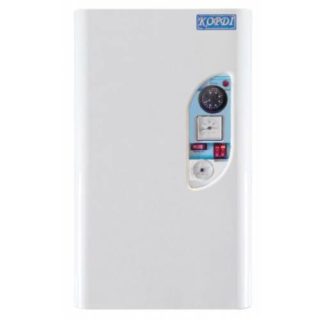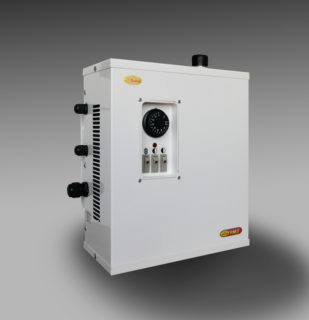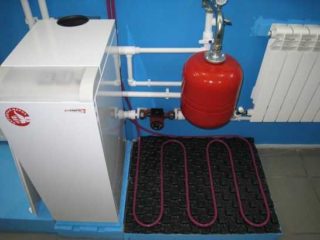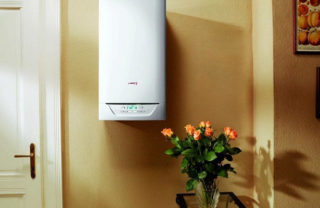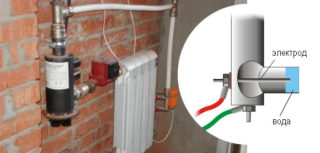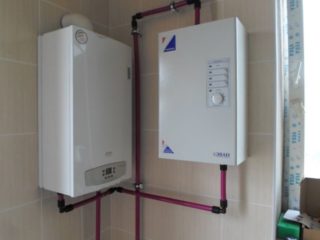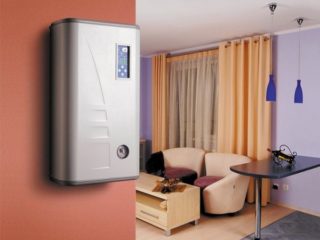To create a heat supply system, they began to install more often electric boilers for heating a private house at 220 V. They are much safer than gas units and have several advantages. Electric boilers can be used for heating residential, public and commercial buildings. They are independent of the supply of natural fuel. Such units belong to environmentally friendly heat and power equipment, since they are not sources of emissions of pollutants into the atmosphere.
Criteria for choosing an electric boiler
The thermal power of electric boilers refers to the main indicator and is measured in kW. It characterizes the amount of heat spent on heating the water in the heating circuit in order to maintain the sanitary temperature of the indoor air in the room. This value should compensate for the loss of thermal energy in the heated rooms, and in the case of the installation of double-circuit boilers - to ensure the operation of the DHW system. At the same time, it is necessary to buy a 220 V heating electric boiler with a small power reserve in order to compensate for the drop in the efficiency that occurs due to power surges.
Type of building
Distinguish single-circuit and double-circuit electric boilers. The difference is in the additional functions of the second circuit for heating the hot water supply. The simplest modifications are supplied only with built-in capacity and electric heating elements, and more complex designs of a double-circuit wall-mounted electric boiler have an expansion tank and an electronic control unit with protective functions.
Boiler price
The cost of the electric boiler is most affected by the level of equipment. The more functions the boiler has, the higher the cost. Premium electric modifications of boilers have an expansion tank that compensates for the expansion of water in the internal circuit during heating and a pump for circulating network water.
The assembly includes safety and regulation units that guarantee the protection of the unit and the heating system from overheating and overpressure. Without them, the boiler is much cheaper, but since they are needed technologically, they will still need to be bought. As a result, the electric boiler with the maximum configuration comes out cheaper than the budget option, requiring the purchase of additional boiler equipment.
Power Stability
Despite the fact that this performance parameter does not directly affect the design of the 220 V electric boiler for heating in a private house, it must be taken into account when choosing devices. The use of a single-phase 220 V network allows the installation of electric boilers only with a capacity of up to 12 kW.
To ensure the stability of the electrical equipment, you must correctly select the cross-sectional area of the cable. This parameter is selected based on the loads and recommendations of the manufacturer.
Separation of boilers at the installation site
Electric heat generators are divided into two types depending on the case version: floor and wall mounted.
Floor
Boilers have maximum power, large dimensions and an additional circuit for hot water.They are installed as the main source of heat supply and can be paired with external hot water storage tanks. Main advantages:
- the ability to provide heat to individual houses with an area of more than 200 m2;
- rapid heating of hot water.
The efficiency of such a heat supply system will depend on the use of diphtharithmic accounting of electric energy and the level of thermal protection of the building.
These modifications have several disadvantages:
- high consumption of electric energy for heat generation;
- the need for an isolated room for boilers;
- the need for a separate power line.
When installing a floor boiler, all the requirements of the manufacturer and current state standards for the safe operation of electrical equipment must be met.
Mounted
Electric boilers are designed for heating cottages and small-sized individual houses. Sometimes they are used in schemes of backup or additional boiler equipment, which is put into operation when the main, for example, solid fuel boiler fails.
The main advantages of mounted units are:
- insignificant specific energy consumption for heat generation;
- compactness and small size;
- no prohibitions at the installation site
The disadvantages of this design include low power and low level of equipment. The owner will need to purchase many auxiliary components of the heating system on their own.
Models of boilers for execution
Depending on the method of heating the coolant, electric boilers are electrode, induction and heating elements. Which type to choose for installation in the house will depend on the preferences of the owner, the possibilities of house wiring and the availability of free space for the arrangement of the boiler.
Heating elements
This is a traditional type of electric boiler 220 volts. In it, the hot medium is heated by heating elements made of a metal tubular body, inside which a nichrome spiral is embedded. The distance between it and the body is filled with dielectric material, which usually is quartz sand. The boiler can have one or several heating elements, depending on the power and heating circuits. Such a device works on the principle of an electric kettle.
Electrode
These devices use water ionization technology. For efficient heating, such devices require water that has undergone specialized training. Depending on this, the amount of electricity required for heating will change. Such devices require a solid grounding circuit.
Induction electric boilers have a complex heating system and a high price. Installation of a large number of functional units will require a separate room. This unit uses the principle of a transformer and is made of primary and secondary windings. After starting, the primary, consuming electrical energy, creates a magnetic field on the secondary winding. The ferromagnetic core heats up and transfers thermal energy to the heating medium.
DIY installation
Initially, before installing the electric boiler, installation marking is made in the selected place. When placing the floor apparatus, a fireproof metal sheet is installed on the surface. For wall modification, the installation site is protected by non-combustible building materials, then factory mounting elements are fixed on the wall, under which holes are made. In the process, check the horizontal installation using the building level.
When connecting an electric boiler to the supply network, grounding is performed.Some boiler configurations do not turn on at all without an earthing circuit. Wiring from it leads to an individual UZO machine, to which an electrical outlet is connected to turn on the heating device. The manufacturer indicates the smallest square cross-section of the cable in the annotation on the use of equipment. Electric wires should be hidden in the cable channel. After completing the strapping on the electric line, the boiler casing is installed in place, the power is connected and the operation of the electrical units is tested.
Connection to the heating system
After installing the boiler and checking the operation of the power supply system, the unit is tied to existing domestic heating and hot water supply networks.
The heating boiler, in the housing of which there is a pump for circulating network water along the circuits, is connected to the system in this way:
- The supply and return pipelines are connected to the inlet pipes using ball valves with “American women”.
- On the return line in front of the boiler, a mud filter is mounted, in front of which a ball valve is inserted for easy cleaning, and an expansion tank with a membrane operating principle.
- After installing all the auxiliary equipment, necessary fittings and primary sensors for temperature and pressure of the heating medium, the water circuit is crimped. The heating circuit is filled with purified water and the system is tested for strength and absence of leaks.
The pressure required for the pressure test is indicated by the manufacturer, it is pumped by a compressor or pump.
Advantages and disadvantages
The main advantage of heating electric boilers in comparison with other types of heating are their environmental functions and environmental safety. They work almost inaudibly, in connection with which it is allowed to place such equipment inside the house. At the same time, electric boilers equipped with a control unit are able to function in automatic mode. They do not need to equip smoke ventilation systems, which significantly reduces the total cost of installation work.
An electric boiler with a single-phase connection has one significant drawback - this is an expensive type of heating. Even a high plant efficiency of 98% cannot compensate for the high energy costs.
Electric heaters integrate well with unconventional types of energy: the sun, wind and heat pumps. This significantly reduces the cost of heat generation and makes them competitive energy-saving sources.
